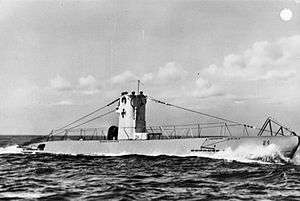German submarine U-14 (1935)
German submarine U-14 was a Type IIB U-boat of Nazi Germany's Kriegsmarine during World War II. It served with 3rd U-boat Flotilla from 18 January 1936 to 31 October 1939. U-14 completed six wartime patrols and sank nine ships totalling 12,344 GRT.
 U-9, a typical Type IIB boat | |
| History | |
|---|---|
| Name: | U-14 |
| Ordered: | 2 February 1935 |
| Builder: | Deutsche Werke, Kiel |
| Yard number: | 249 |
| Laid down: | 6 July 1935 |
| Launched: | 28 December 1935 |
| Commissioned: | 18 January 1936 |
| Fate: | Scuttled on 2 May 1945 at Wilhelmshaven |
| General characteristics | |
| Class and type: | IIB coastal submarine |
| Displacement: |
|
| Length: |
|
| Beam: |
|
| Height: | 8.60 m (28 ft 3 in) |
| Draught: | 3.90 m (12 ft 10 in) |
| Installed power: |
|
| Propulsion: |
|
| Range: |
|
| Test depth: | 80 m (260 ft) |
| Complement: | 3 officers, 22 men |
| Armament: |
|
| Service record | |
| Part of: | |
| Identification codes: | M 28 451 |
| Commanders: |
|
| Operations: | Six |
| Victories: | Nine ships sunk for a total of 12,344 GRT |
Design
German Type IIB submarines were enlarged versions of the original Type IIs. U-14 had a displacement of 279 tonnes (275 long tons) when at the surface and 328 tonnes (323 long tons) while submerged. Officially, the standard tonnage was 250 long tons (250 t), however.[1] The U-boat had a total length of 42.70 m (140 ft 1 in), a pressure hull length of 28.20 m (92 ft 6 in), a beam of 4.08 m (13 ft 5 in), a height of 8.60 m (28 ft 3 in), and a draught of 3.90 m (12 ft 10 in). The submarine was powered by two MWM RS 127 S four-stroke, six-cylinder diesel engines of 700 metric horsepower (510 kW; 690 shp) for cruising, two Siemens-Schuckert PG VV 322/36 double-acting electric motors producing a total of 460 metric horsepower (340 kW; 450 shp) for use while submerged. She had two shafts and two 0.85 m (3 ft) propellers. The boat was capable of operating at depths of up to 80–150 metres (260–490 ft).[1]
The submarine had a maximum surface speed of 12 knots (22 km/h; 14 mph) and a maximum submerged speed of 7 knots (13 km/h; 8.1 mph).[1] When submerged, the boat could operate for 35–42 nautical miles (65–78 km; 40–48 mi) at 4 knots (7.4 km/h; 4.6 mph); when surfaced, she could travel 3,800 nautical miles (7,000 km; 4,400 mi) at 8 knots (15 km/h; 9.2 mph). U-14 was fitted with three 53.3 cm (21 in) torpedo tubes at the bow, five torpedoes or up to twelve Type A torpedo mines, and a 2 cm (0.79 in) anti-aircraft gun. The boat had a complement of twentyfive.[1]
Service history
Early in the war, on 3 September 1939, U-14 attacked a Polish submarine and claimed to have sunk it. In reality the Polish submarine, ORP Sęp, was not damaged as the torpedo launched by U-14 exploded prematurely.[2]
After serving on six operational patrols, U-14 was used as a training boat and transferred to U-boat training flotillas, serving with the 23rd and 24th U-boat Flotillas until the end of the war. Despite the high casualties suffered by the Unterseebootwaffen (German submarine arm), U-14 suffered no known casualties during the war.
U-14 was scuttled on 2 May 1945 at Wilhelmshaven.
Summary of raiding history
| Date | Name | Nationality | Tonnage (GRT) |
Fate[3] |
|---|---|---|---|---|
| 25 January 1940 | Biarritz | 1,752 | Sunk | |
| 15 February 1940 | Sliepner | 1,066 | Sunk | |
| 16 February 1940 | Liana | 1,646 | Sunk | |
| 16 February 1940 | Osmed | 1,526 | Sunk | |
| 16 February 1940 | Rhone | 1,064 | Sunk | |
| 7 March 1940 | Vecht | 1,965 | Sunk | |
| 9 March 1940 | Abbotsford | 1,585 | Sunk | |
| 9 March 1940 | Akeld | 643 | Sunk | |
| 9 March 1940 | Borthwick | 1,097 | Sunk |
References
- Gröner 1991, pp. 39–40.
- "ORP Sęp - Operational History". www.polishnavy.pl. Archived from the original on 7 June 2011. Retrieved 2010-01-09.
- Helgason, Guðmundur. "Ships hit by U-14". German U-boats of WWII - uboat.net. Retrieved 29 December 2014.
Bibliography
- Busch, Rainer; Röll, Hans-Joachim (1999). German U-boat commanders of World War II : a biographical dictionary. Translated by Brooks, Geoffrey. London, Annapolis, Md: Greenhill Books, Naval Institute Press. ISBN 1-55750-186-6.CS1 maint: ref=harv (link)
- Busch, Rainer; Röll, Hans-Joachim (1999). Deutsche U-Boot-Verluste von September 1939 bis Mai 1945 [German U-boat losses from September 1939 to May 1945]. Der U-Boot-Krieg (in German). IV. Hamburg, Berlin, Bonn: Mittler. ISBN 3-8132-0514-2.CS1 maint: ref=harv (link)
- Gröner, Erich; Jung, Dieter; Maass, Martin (1991). U-boats and Mine Warfare Vessels. German Warships 1815–1945. 2. Translated by Thomas, Keith; Magowan, Rachel. London: Conway Maritime Press. ISBN 0-85177-593-4.
- Bishop, Chris (2006). Kriegsmarine U-Boats, 1939-45. London: Amber Books. ISBN 978-1-904687-96-2.
External links
- Helgason, Guðmundur. "The Type IIB boat U-14". German U-boats of WWII - uboat.net. Retrieved 6 December 2014.
- Hofmann, Markus. "U 14". Deutsche U-Boote 1935-1945 - u-boot-archiv.de (in German). Retrieved 30 January 2015.